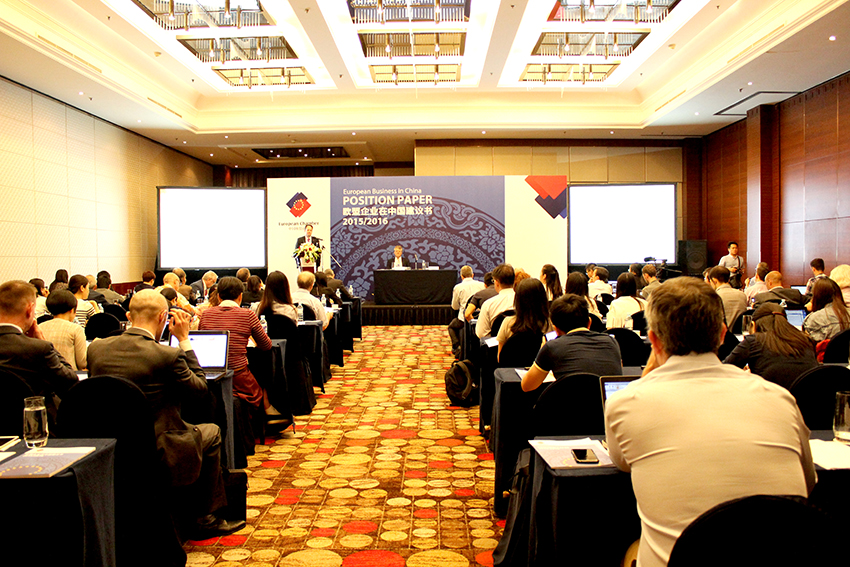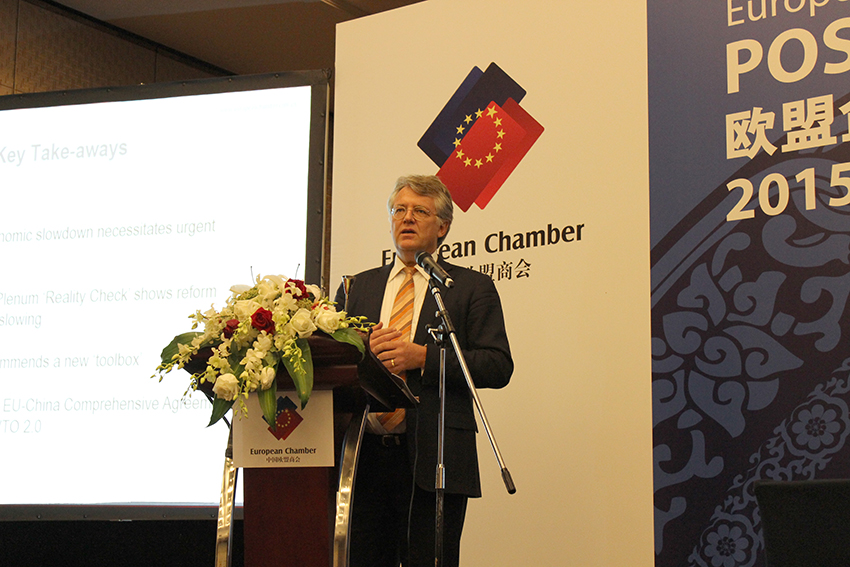The European Business in China Position Paper 2015/2016 is launched
On 8th September, the European Chamber launched our European Business in China Position Paper 2015/2016. The morning launch event was attended by 80 Chinese and foreign media, with 69 original reports being filed by all major international media outlets such as the Financial Times, Wall Street Journal, Bloomberg, Washington Post and Reuters. The Position Paper was also reported on by Chinese domestic media, such as Caijing, Xinhua, Caixin and Sohu, and related stories were disseminated via all major newswires.
This year’s paper includes clear policy recommendations to the Chinese Government on how they can effectively launch China’s next wave of productivity, a ‘reality check’ of the Third Plenum’s reform agenda and proposals from European business to the European Commission as to what they want to be included in the ongoing EU-China Comprehensive Agreement on Investment negotiations. What follows is the Position Paper Executive Summary.
Executive Summary
The Chinese economy is faced with the onset of a permanent slowdown. To mitigate its adverse effects the Chinese Government needs to change its old ways.
Foreign business hailed the promulgation of the Third Plenum’s Decision,[1] China’s reform vision until 2020. Two years on, it is now clear that some reform momentum has been lost and the hopes of foreign business have given way to a more subdued optimism in an emerging political-economic environment that can be described as one of ‘reform and closing up’.
The Chinese Government must avoid giving in to the protectionist tendencies that are continuing to curtail legitimate market access, whether on the grounds of national security or other concerns. Its most pressing issue now is how to forge ahead with the reforms that will help to bring about the rebalancing of the economy. China needs to employ a ‘new toolbox’ capable of successfully delivering an economic model that the European Chamber defines as:
“An economic model in which market forces decide the allocation of resources in the economy under the auspices of rule of law; consumption holds a significantly larger share of GDP; there exists no discrimination between domestic and foreign investment; there is harmonisation with global standards and supply chains; and the state plays a reduced role in the economy, acting solely as regulator and enforcer. An economy in which—due to a more sophisticated regulatory environment—the services sector has become the dominant engine of growth, supported by an education system and a flexible and open labour market that endow China’s workforce with the required skillset. An economic model that will result in greater innovative capacity and a higher quality of life for the individual.”
In order to get there, China will need to address a number of key challenges.
- The Reality Check
1.1 The Chinese Economic Slowdown
China’s gross domestic product (GDP) growth dropped to seven per cent in the first half of 2015,[2] the lowest level since 2009. Financial leverage is precipitously high, with total debt having ballooned to
282 per cent of GDP in 2014.[3] China’s total trade declined by 6.9 per cent in the first half of 2015,[4] and aggregate productivity of China’s economy is also at a significant low.[5] European companies have reported for the third year in a row that their earnings before interest and tax (EBIT) margins are more likely to be greater outside of China than they are inside China.[6] The four successive interest rate cuts from November 2014 to mid-2015, and the volatility and sharp declines in the Chinese stock market in 2015, point towards increasing misgivings over whether China actually retains the capacity to meet its projected economic growth targets.
1.2 Towards the ‘New Normal’
In brief, the ‘new normal’ will be an era characterised by lower, but more qualitative economic growth.
1.3 Third Plenum Reality Check
European business fully subscribes to the principle that China has to “let the market play the decisive role in allocating resources and let the government play its functions better.”[7] However, European business is now witnessing the government’s reform agenda seemingly occupying opposite ends of the spectrum: both improvements and deteriorations are taking place to varying degrees.
- The ‘New Toolbox’
2.1 Accelerating Reform of the Financial System
China’s financial system needs to become more efficient in allocating capital if the economy is to grow more sustainably. This has to be at the core of the government’s reform drive and will require some fundamental reforms to ensure that funds are being lent on a more viable basis.
2.2 Limiting State Engagement in the Economy
Over the last few decades, the state loomed large in the Chinese economy. It has been dominated by strong state-owned enterprises (SOEs), to which the government channelled the population’s savings in order to develop large-scale projects on the back of clearly defined industrial policies. This approach has been costly and inefficient, and has to be abandoned now if the market is to play a decisive role in the economy.
2.3 Increasing Market Access for the Private Sector, Including Foreign Business
One of the greatest policy tools that is still at the Chinese Government’s disposal—unlike many governments in developed economies—is the possibility of allowing the private sector to fully play out within the economy and to harness the substantial gains this will bring. China needs to establish an open market economy in order to unlock the substantial potential of private companies. This was clearly recognised in the Decision, but uncertainty remains over whether it will be forthcoming.
2.4 Committing to the Rule of Law
Greater implementation of rule of law is undoubtedly the most important tool in the box and will be the top driver for China’s economic development in the coming years.[8] Transparency, legal certainty and public consultation are all central elements of rule of law that will ensure the proper functioning of an economy. However, China needs to do more to increase investors’ trust in its judicial system.
2.5 Abolishing the Foreign Investment Catalogues and Committing to a Nationwide Roll-out of the Negative List
The continued adherence to the Foreign Investment Industry Guidance Catalogue falls short of the
Chinese Government’s stated ambition to give full play to the market. Instead, China should proceed with a nationwide roll-out of the ‘negative-list’ approach.
2.6 Fostering an Innovative Environment
Innovation is one of the most important drivers of economic growth. In order for China to successfully create the right conditions for it to take place it must, first and foremost, guarantee a competitive market that is open to all companies, regardless of nationality. China also needs to have an education system and a flexible and open labour market in place, which is capable of continually improving its workforce.
- China and the World
3.1 National Security Concerns
In 2015, several Chinese government agencies have issued a number of laws that make reference to national security. The definitions included in these laws are very vague, which creates a great deal of uncertainty for business and is detrimental to the credibility of the Chinese marketplace.
3.2 China’s New International Institutions
China is swiftly and resolutely moving ahead with developing its own set of international institutions and development agendas – this could profoundly shape the future of the global trading system.
European business welcomes these developments, but thinks that China should prioritise taking a greater leadership role in the established global trading system, with the World Trade Organisation (WTO) at its centre.
3.3 Taking a Leading Role in Global Affairs
China has benefitted immensely from its entry into the WTO some 15 years ago, and now has the opportunity to shape and ensure the success of future development rounds by, among other things, lobbying for progress with the Doha Development Agenda and making a more compelling, revised offer to join the Government Procurement Agreement.[9]
- Expectations of the European Union
The European Chamber believes the European Union’s (EU’s) economic and trade relations with
China should be prioritised. Despite its challenging business environment, China still offers significant potential to European companies, including small and medium-sized enterprises. As such, European business views the ongoing negotiations for an EU-China Comprehensive Agreement on Investment as the biggest opportunity to reset EU-China relations and boost the fledging growth of both economic blocs.
- The Audacity to Change
The Chinese leadership is faced with the considerable challenge of successfully navigating the adverse effects of permanently lower economic growth. A large part of the solution will be the successful transition to the ‘new normal’, an era in which China will embrace an economic model that can deliver sustainable, qualitative growth. This is well within the Chinese Government’s reach if it can have the courage of its convictions and stick to the bold reform pledges made in the Decision.
A successful rebalancing of the Chinese economy will require an adroit sequencing of macroeconomic policies; it will require the ability to let go of the impulse to micro-manage the domestic economy; and it will require the courage to follow through with overdue, but critical, structural reforms. In short, it will require the audacity to change.
Please download a full copy of the Position Paper from the Chamber’s website.
[1] The Third Plenum of the 18th National Congress of the Communist Party of China Central Committee was held in November 2013, and concluded with a decision laying out new economic and policy initiatives – the Decision of the Central Committee of the Communist Party of China on Some Major Issues Concerning Comprehensively Deepening the Reform (Decision).
[2] China Surprises With 7% Growth in Second Quarter, Wall Street Journal, 15th July, 2015, viewed 20th July, 2015, <http://www.cnbc.com/2015/07/14/>
[3] Debt and (not much) deleveraging, McKinsey, February 2015, viewed 29th June, 2015, <http://www.mckinsey.com/insights/economic_studies/debt_and_not_much_
deleveraging>
[4] China trade slumps in first half of year, dealing blow to global economy, The Guardian, 13th July, 2015, viewed 21st July, 2015, <http://www.theguardian.com/business/2015/jul/13/china-trade-slumps-first-half-year-blow-global-economy>
[5] Hoffman, D., Polk, A., The Long Soft Fall in Chinese Growth: Business Realities, Risks and Opportunities, The Conference Board, 2014, viewed 16th July, 2015, <https://www.conference-board.org/retrievefile.cfm?filename=KBI-FY15—China-Slowdown—Final-Draftv2.pdf&type=subsite>
[6] European Business in China Business Confidence Survey 2015, European Union Chamber of Commerce in China, June 2015, page 50, <http://www.europeanchamber.com.cn/en/publications-business-confidence-survey>
[7] The Decision.
[8] European Business in China Business Confidence Survey 2015, European Union Chamber of Commerce in China, June 2015, page 39, <http://www.europeanchamber.com.cn/en/publications-business-confidence-survey>
[9] Agreement on Government Procurement, World Trade Organisation, 2015 (updated information), viewed 10th July, 2015, <https://www.wto.org/english/tratop_e/gproc_e/gp_gpa_e.htm>




Recent Comments